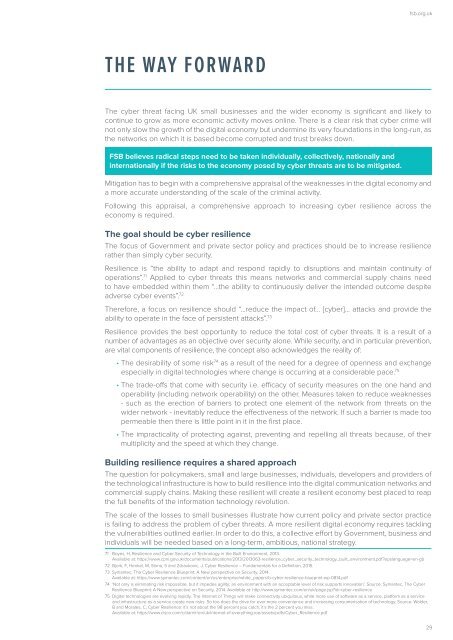CYBER RESILIENCE HOW TO PROTECT SMALL FIRMS IN THE DIGITAL ECONOMY
FSB-Cyber-Resilience-report-2016
FSB-Cyber-Resilience-report-2016
You also want an ePaper? Increase the reach of your titles
YUMPU automatically turns print PDFs into web optimized ePapers that Google loves.
fsb.org.uk<br />
<strong>THE</strong> WAY FORWARD<br />
The cyber threat facing UK small businesses and the wider economy is significant and likely to<br />
continue to grow as more economic activity moves online. There is a clear risk that cyber crime will<br />
not only slow the growth of the digital economy but undermine its very foundations in the long-run, as<br />
the networks on which it is based become corrupted and trust breaks down.<br />
FSB believes radical steps need to be taken individually, collectively, nationally and<br />
internationally if the risks to the economy posed by cyber threats are to be mitigated.<br />
Mitigation has to begin with a comprehensive appraisal of the weaknesses in the digital economy and<br />
a more accurate understanding of the scale of the criminal activity.<br />
Following this appraisal, a comprehensive approach to increasing cyber resilience across the<br />
economy is required.<br />
The goal should be cyber resilience<br />
The focus of Government and private sector policy and practices should be to increase resilience<br />
rather than simply cyber security.<br />
Resilience is “the ability to adapt and respond rapidly to disruptions and maintain continuity of<br />
operations”. 71 Applied to cyber threats this means networks and commercial supply chains need<br />
to have embedded within them “…the ability to continuously deliver the intended outcome despite<br />
adverse cyber events”. 72<br />
Therefore, a focus on resilience should “…reduce the impact of... [cyber]... attacks and provide the<br />
ability to operate in the face of persistent attacks”. 73<br />
Resilience provides the best opportunity to reduce the total cost of cyber threats. It is a result of a<br />
number of advantages as an objective over security alone. While security, and in particular prevention,<br />
are vital components of resilience, the concept also acknowledges the reality of:<br />
• The desirability of some risk 74 as a result of the need for a degree of openness and exchange<br />
especially in digital technologies where change is occurring at a considerable pace. 75<br />
• The trade-offs that come with security i.e. efficacy of security measures on the one hand and<br />
operability (including network operability) on the other. Measures taken to reduce weaknesses<br />
- such as the erection of barriers to protect one element of the network from threats on the<br />
wider network - inevitably reduce the effectiveness of the network. If such a barrier is made too<br />
permeable then there is little point in it in the first place.<br />
• The impracticality of protecting against, preventing and repelling all threats because, of their<br />
multiplicity and the speed at which they change.<br />
Building resilience requires a shared approach<br />
The question for policymakers, small and large businesses, individuals, developers and providers of<br />
the technological infrastructure is how to build resilience into the digital communication networks and<br />
commercial supply chains. Making these resilient will create a resilient economy best placed to reap<br />
the full benefits of the information technology revolution.<br />
The scale of the losses to small businesses illustrate how current policy and private sector practice<br />
is failing to address the problem of cyber threats. A more resilient digital economy requires tackling<br />
the vulnerabilities outlined earlier. In order to do this, a collective effort by Government, business and<br />
individuals will be needed based on a long-term, ambitious, national strategy.<br />
71 Boyes, H, Resilience and Cyber Security of Technology in the Built Environment, 2013.<br />
Available at: https://www.cpni.gov.uk/documents/publications/2013/2013063-resilience_cyber_security_technology_built_environment.pdf?epslanguage=en-gb<br />
72 Bjork, F, Henkel, M, Stirna, S and Zdravkovic, J, Cyber Resilience – Fundamentals for a Definition, 2015.<br />
73 Symantec, The Cyber Resilience Blueprint: A New perspective on Security, 2014.<br />
Available at: https://www.symantec.com/content/en/us/enterprise/white_papers/b-cyber-resilience-blueprint-wp-0814.pdf<br />
74 ‘Not only is eliminating risk impossible, but it impedes agility; an environment with an acceptable level of risk supports innovation’. Source: Symantec, The Cyber<br />
Resilience Blueprint: A New perspective on Security, 2014. Available at: http://www.symantec.com/en/uk/page.jsp?id=cyber-resilience<br />
75 Digital technologies are evolving rapidly. The Internet of Things will make connectivity ubiquitous, while more use of software as a service, platform as a service<br />
and infrastructure as a service create new risks. So too does the drive for ever more convenience and increasing consumerisation of technology. Source: Walder,<br />
B and Morales, C, Cyber Resilience: it’s not about the 98 percent you catch, it’s the 2 percent you miss.<br />
Available at: https://www.cisco.com/c/dam/r/en/uk/internet-of-everything-ioe/assets/pdfs/Cyber_Resilience.pdf<br />
29


